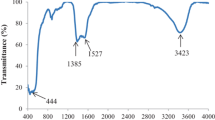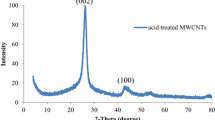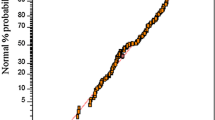Abstract
Multi-walled carbon nanotubes (MWCNTs) have been successfully modified with TiO2 nanoparticles via a two-step hydrolysis technique. Firstly, the pristine MWCNTs are functionalized in nitric acid (HNO3) to creation of oxygen containing groups. Secondly, TiO2 nanoparticles are synthesized on the surface of functionalized MWCNTs through hydrolysis method. The synthesized samples have been used as photocatalyst for decomposition of methyl orange (MO) as dye organic pollutant. The characterization of samples using X-ray diffraction pattern (XRD) confirm the presence of TiO2 nanoparticles with mixture of anatase and rutile phases. Regarding the photocatalytic performance of TiO2 nanoparticles and modified MWCNTs with TiO2 nanoparticles, it observed that the degradation rate of MO increases by increasing the irradiation time from 5 to 35 min. The variation of degradation rate upon pH of suspension reveals that the maximum and minimum degradation rate are in acidic (pH = 3) and neutral condition (pH = 7). Meanwhile, the results show that the presence of MWCNTs leads to the enhancement of degradation rate. The analysis of variance (ANOVA) results confirm that both of main factors (irradiation time and pH) and their interaction have a significant influence on the degradation rate of MO. However, the effect of irradiation time is more than that of pH and their interaction. The graphical methods verify the quality and adequacy of the statistical models for prediction of the degradation rate.
















Similar content being viewed by others
References
N. Bouazza, M. Ouzzine, M.A.L.-R. Denas, D. Eder, A. Linares-Solano, TiO2 nanotubes and CNT–TiO2 hybrid materials for the photocatalytic oxidation of propene at low concentration. Appl. Catal. B 92, 377–383 (2009)
Y. Dong, D. Tang, C. Li, Photocatalytic oxidation of methyl orange in waterphase by immobilized TiO2–carbon nanotube nanocomposite photocatalyst. Appl. Surf. Sci. 296, 1–7 (2014)
S. Abbasi, M.-S. Ekrami-Kakhki, M. Tahari, Modeling and predicting the photodecomposition of methylene blue via ZnO-SnO2 hybrids using design of experiments (DOE). J. Mater. Sci. 28, 15306–15312 (2017)
X.-T. Yin, J. Li, D. Dastan, W.-D. Zhou, H. Garmestani, F.M. Alamgir, Ultra-high selectivity of H2 over CO with a p-n nanojunction based gas sensors and its mechanism. Sens. Actuatators 319, 128330 (2020)
K. Shan, F. Zhai, Z. Yi, X. Yin, D. Dastan, F. Tajabadi, A. Jafari, S. Abbasi, Mixed conductivity and the Conduction Mechanism Of The Orthorhombic CaZrO3 based materials. Surf. Interfaces 23, 100905 (2021)
K. Shan, Z. Yi, X. Yin, D. Dastan, H. Garmestani, Y-doped CaZrO3/Co3O4 as novel dense diffusion barrier materials for limiting current oxygen sensor. Dalton Trans. 49, 8549–8556 (2020)
G. Zhu, H. Wang, G. Yang, L. Chen, P. Guo, L. Zhang, A facile synthesis of ZnO/CNTs hierarchical mircosphere composites with enhanced photocatalytic degradation of methylene blue. RSC Adv. 5, 2476–72481 (2015)
A. Ghaderi, S. Abbasi, F. Farahbod, Synthesis, characterization and photocatalytic performance of modified ZnO nanoparticles with SnO2 nanoparticles. Mater. Res. Express 5, 065908 (2018)
N. Roozban, S. Abbasi, M. Ghazizadeh, The experimental and statistical investigation of the photo degradation of methyl orange using modified MWCNTs with different amount of ZnO nanoparticles. J. Mater. Sci. 28, 7343–7352 (2017)
A. Ghaderi, S. Abbasi, F. Farahbod, Synthesis of SnO2 and ZnO nanoparticles and SnO2-ZnO hybrid for the photocatalytic oxidation of methyl orange. Iran. J. Chem. Eng. 12, 96–105 (2015)
H. Wang, S. Baek, J. Lee, S. Lim, High photocatalytic activity of silver-loaded ZnO-SnO2 coupled catalysts. Chem. Eng. J. 146, 355–361 (2009)
N. Zhou, L. Polavarapu, N. Gao, Y. Pan, P. Yuan, Q. Wang, Q.-H. Xu, TiO2 coated Au/Ag nanorods with enhanced photocatalytic activity under visible light irradiation. Nanoscale 5, 4236–4241 (2013)
S. Abbasi, M. Hasanpour, M.S.E. Kakhki, Removal efficiency optimization of organic pollutant (methylene blue) with modified multi-walled carbon nanotubes using design of experiments (DOE). J. Mater. Sci. 28, 9900–9910 (2017)
S. Abbasi, Investigation the kinetic reaction variation of the methyl orange decomposition using decorated multi-walled carbon nanotubes with ZnO nanoparticles, influence of nanoparticle content. J. Environ. Health Eng. 5, 113–122 (2018)
S. Abbasi, F. Ahmadpoor, M. Imani, M.-S. Ekrami-Kakhki, Synthesis of magnetic Fe3O4@ZnO@graphene oxide nanocomposite for photodegradation of organic dye pollutant. Int. J. Environ. Anal. Chem. 100, 225–240 (2020)
S.P. Kim, M.Y. Choi, H.C. Choi, Characterization and photocatalytic performance of SnO2–CNTnanocomposites. Appl. Surf. Sci. 357, 302–308 (2015)
S. Abbasi, M. Hasanpour, F. Ahmadpoor, M. Sillanpää, D. Dastan, A. Achour, Application of the statistical analysis methodology for photodegradation of methyl orange using a new nanocomposite containing modified TiO2 semiconductor with SnO2. Int. J. Environ. Anal. Chem. 101, 208–224 (2021)
K. Shan, Z. Yi, X. Yin, D. Dastan, S. Dadkhah, B. Coates, H. Garmestani, Mixed conductivities of A-site deficient Y, Cr-doubly doped SrTiO3 as novel dense diffusion barrier and temperature-independent limiting current oxygen sensors. Adv. Powder Technol. 31, 4657–4664 (2020)
L. Sun, Z. Shi, L. Liang, S. Wei, H. Wang, D. Dastan, K. Sun, R. Fan, Layer-structured BaTiO3/P(VDF-HFP) composites with concurrently improved dielectric permittivity and breakdown strength toward capacitive energystorage applications. J. Mater. Chem. C 8, 10257–10265 (2020)
L. Sun, Zh. Shi, H. Wang, K. Zhang, D. Dastan, K. Sun, R. Fan, Ultrahigh discharge efficiency and improved energy density in rationally designed bilayer polyetherimide-BaTiO3/P(VDF-HFP) composites. J. Mater. Chem. A 8, 5750–5757 (2020)
W. Zhang, X. Zhu, L. Liang, P. Yin, P. Xie, D. Dastan, K. Sun, R. Fan, Z. Shi, Significantly enhanced dielectric permittivity and low loss in epoxy composites incorporating 3d W-WO3/BaTiO3 foams. J. Mater. Sci. 56, 4254–4265 (2021)
D.A. Reddy, R. Ma, T.K. Kim, Efficient photocatalytic degradation of methyleneblue by heterostructured ZnO-RGO/RuO2 nanocomposite under thesimulated sunlight irradiation. Ceram. Int. 41, 6999–7009 (2015)
M. Ahmad, E. Ahmed, Z.L. Hong, X.L. Jiao, T. Abbas, N.R. Khalid, Enhancementin visible light-responsive photocatalytic activity byembedding Cu-doped ZnO nanoparticles on multi-walled carbonnanotubes. Appl. Surf. Sci 285, 702–712 (2013)
S. Abbasi, Investigation of the enhancement and optimization of the photocatalytic activity of modified TiO2 nanoparticles with SnO2 nanoparticles using statistical method. Mater. Res. Express 5, 066302 (2018)
S. Abbasi, Photocatalytic activity study of coated anatase-rutile titania nanoparticles with nanocrystalline tin dioxide based on the statistical analysis. Environ. Monit. Assess. 191, 206–218 (2019)
D. Dastan, Nanostructured anatase titania thin films prepared by sol-gel dip coating technique. J. Atomic Mol. Condens. Nano Phys. 2, 109–114 (2015)
D. Dastan, N.B. Chaure, Influence of surfactants on TiO2 nanoparticles grown by sol-gel technique. J. Mater. Mech. Manufact 2, 21–24 (2014)
S. Abbasi, S.M. Zebarjad, S.H.N. Baghban, Decorating and filling of multi-walled carbon nanotubes with TiO2 nanoparticles via wet chemical method. Engineering 5, 207–212 (2013)
S. Abbasi, S.M. Zebarjad, S.H.N. Baghban, A. Youssefi, Synthesis of TiO2 nanoparticles and decorated multiwalled carbon nanotubes with various content of rutile titania. Synth. React. Inorg. Met.-Org. Nano-Met. Chem. 45, 1539–1548 (2015)
N. Roozban, S. Abbasi, M. Ghazizadeh, Statistical analysis of the photocatalytic activity of decorated Multi-Walled carbon nanotubes with ZnO nanoparticles. J. Mater. Sci. 28, 6047–6055 (2017)
S. Abbasi, Photocatalytic removal of methyl orange in suspension containing ZnO and SnO2 nanoparticles and investigation the influence of effective variables on the process. Iran. J. Health Environ. 9, 433–442 (2016)
S. Abbasi, Adsorption of dye organic pollutant using magnetic ZnO embedded on the surface of graphene oxide. J. Inorg. Organometal. Polym. Mater. 30, 1924–1934 (2020)
S. Abbasi, M. Hasanpour, The effect of pH on the photocatalytic degradation of methyl orange using decorated ZnO nanoparticles with SnO2 nanoparticles. J. Mater. Sci. 28, 1307–1314 (2017)
H. Yuan, J. Xu, Preparation, characterization and photocatalytic activity of nanometer SnO2. Int. J. Chem. Eng. Appl 3, 214–246 (2010)
S. Abbasi, M.-S. Ekrami-Kakhki, M. Tahari, The influence of ZnO nanoparticles amount on the optimisation of photo degradation of methyl orange using decorated MWCNTs. Prog. Ind. Ecol. 13, 3–15 (2019)
S. Abbasi, M. Hasanpour, Variation of the photocatalytic performance of decorated MWCNTs (MWCNTs-ZnO) with pH for photo degradation of methyl orange. J. Mater. Sci. 28, 11846–11855 (2017)
M.-S. Ekrami-Kakhki, S. Abbasi, N. Farzaneh, Statistical analysis of the electrocatalytic activity of Pt nanoparticles supported on novel functionalized reduced graphene oxide-chitosan for methanol electrooxidation. Electron. Mater. Lett. 14, 70–78 (2018)
M. Namvar-Mahboub, M. Pakizeh, Optimization of preparation conditions of polyamide thin film composite membrane for organic solvent nanofiltration. Korean J. Chem. Eng. 31, 327–337 (2014)
M.-S. Ekrami-Kakhki, S. Abbasi, N. Farzaneh, Design of experiments methodology to investigate methanol electrooxidation on Pt nanoparticles supported novel functionalized reduced graphene oxide. Anal. Bioanal. Electrochem. 10, 1548–1561 (2018)
A. Kazemi-Beydokhti, H.A. Namaghi, M.A.H. Asgarkhani, S.Z. Heris, Prediction of stability and thermal conductivity of SNO2 nanofluid via statistical method and an artificial neural network. Braz. J. Chem. Eng. 32, 903–917 (2015)
A. Ahmad, M.I. Ahmad, M. Younas, H. Khan, M.U.H. Shah, A comparative study of alkaline hydrolysis of ethyl acetate using design of experiments. Iran. J. Chem. Chem. Eng. 32, 33–47 (2013)
Acknowledgements
We are thankful from boss of central research laboratory of Esfarayen University of Technology.
Author information
Authors and Affiliations
Corresponding author
Ethics declarations
Conflict of interest
We declare that we have no financial and personal relationships with other people or organization that can inappropriately influence our work.
Additional information
Publisher's Note
Springer Nature remains neutral with regard to jurisdictional claims in published maps and institutional affiliations.
Rights and permissions
About this article
Cite this article
Abbasi, S. Improvement of photocatalytic decomposition of methyl orange by modified MWCNTs, prediction of degradation rate using statistical models. J Mater Sci: Mater Electron 32, 14137–14148 (2021). https://doi.org/10.1007/s10854-021-05707-x
Received:
Accepted:
Published:
Issue Date:
DOI: https://doi.org/10.1007/s10854-021-05707-x




